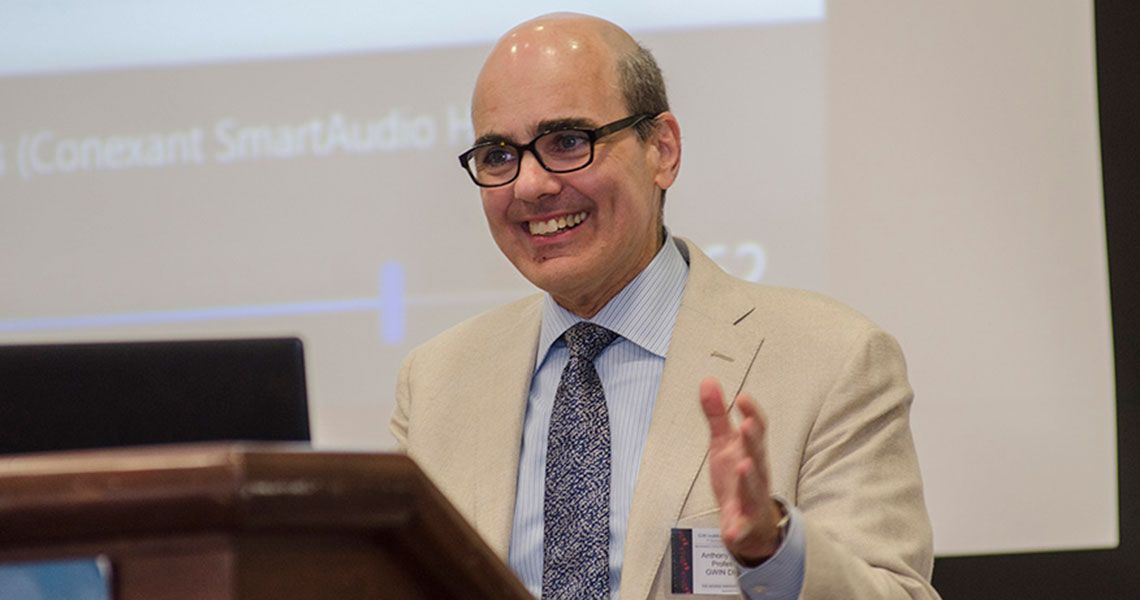George Washington University (GW) scientists, students, and faculty gathered on April 27 for a day-long celebration of the study of the brain during the 7th Annual Neuroscience Symposium, a chance for attendees to learn about research being done around the United States — and in their own backyard.
“This really is not only an opportunity for us to have the renowned and truly fantastic neuroscientists from across the country come and share their work with us, but it’s also an opportunity for us to become more aware of the work that’s being done by our colleagues,” said Anthony S. LaMantia, Ph.D., director of the GW Institute for Neuroscience (GWIN), which sponsors the symposium, and professor of pharmacology and physiology at the GW School of Medicine and Health Sciences (SMHS).
At this year’s event, “New Sensations: Exciting Insights in the Chemical Senses and Social Behaviors,” attendees heard from two nationally renowned neuroscientists, along with students and presenters from SMHS and Children’s National Health System (Children’s National).
“Over the last few years, we’ve seen a real growth in both the recruitment interest and expertise in neuroscience. [If] you look at what’s happened over the last 3-to-5 years … we’ve recruited fantastic faculty, both at the junior level, with people coming in and starting their careers, but also at the more senior level, which I think is important to give it balance,” said Robert Miller, Ph.D., senior associate dean for research, Vivian Gill Distinguished Research Professor, and professor of anatomy and regenerative biology at SMHS.
After an opening round of presentations by SMHS students and faculty members, the first keynote speaker took the stage. Catherine Dulac, Ph.D., Higgins Professor of Molecular and Cellular Biology at Harvard University and investigator at the Howard Hughes Medical Institute, spoke about her research on “Neurobiology of Social Behavior Circuits in the Mouse Brain.”
“Starting with our interest in pheromone detection and then moving into more social behavior research, over the last decade or so my lab has been trying to understand the symptoms that underlie social behavior in mice,” she said.
Much of Dulac’s research centers on investigating the neural mechanisms that control social responses in relation to parental care as well as maternal and paternal behaviors in mice.
In addition, with the human brain, which is geared toward social interaction, Dulac and her colleagues seek to better understand the neurobiology of instinctive social behavior.
Charles Zuker, Ph.D., professor of biochemistry and molecular biophysics and of neuroscience at Columbia University College of Physicians and Surgeons and an investigator at the Howard Hughes Medical Institute, delivered the second keynote, which focused on understanding taste.
Zuker deviated from his original presentation, and instead took the attendees on a journey of the senses with a talk called “Symphony of the Senses.” He challenged the audience members to consider the different ways animals see, hear, and taste; the audience chuckled at learning that mice are indifferent to Diet Coke — they don’t taste aspartame. He also stressed the essential relationship between sensory perceptions and the brain circuits that ultimately account for them.
“Each species lives in its own sensory world, of which others might be tied partially, or may be completely unaware of,” he said.
But taste was the sense of the day, with Zuker outlining his work to identify receptors and cells for sweet, bitter, umami (the Japanese word for “yummy”), salty, and sour, and through that understand how the brain transforms sensory signals into actions and behaviors.
The faculty and student presentations sprinkled throughout the day covered topics including neural control of liver degenerative disease associated with obesity, stress and fear memory, altered brain circuits in mouse models of neurodevelopmental disorders, neurological deficits from molecularly targeted chemotherapeutic drugs that target pediatric cancers, and building a circuit for feeding and swallowing. The event also featured a poster presentation session, a lunch, and a concluding reception.
“As we look toward the future, neuroscience is going to continue to put out tentacles to many other programs [at GW],” Miller said. “The future looks very exciting.”
GWIN is jointly supported by SMHS, the GW Office of the Vice President for Research, and the Columbian College of Arts and Sciences at GW, and works in partnership with the Center for Neuroscience Research at Children’s National.



